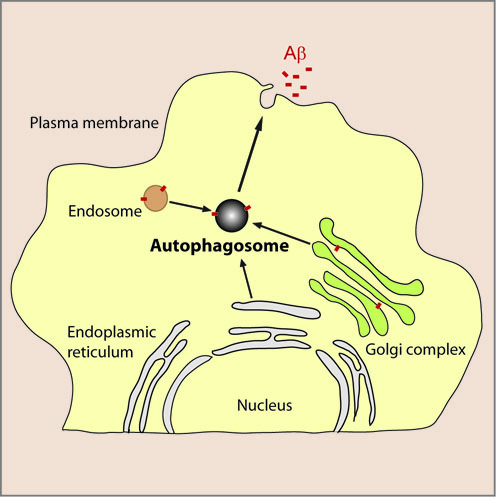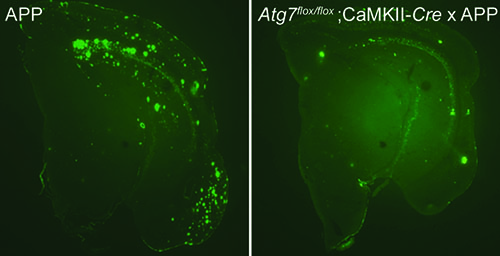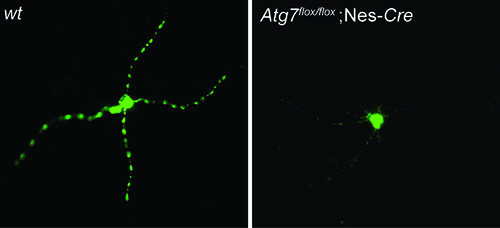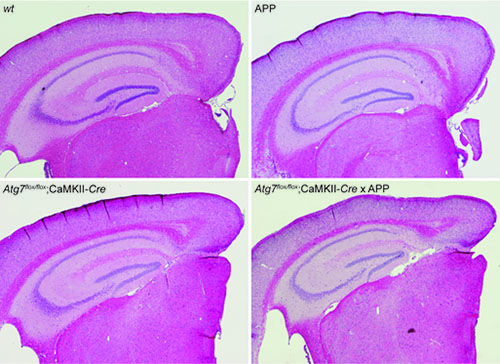Oct. 4, 2013 Press Release Biology Medicine / Disease
Cell auto-cleaning mechanism mediates the formation of plaques in Alzheimer’s
Autophagy, a key cellular auto-cleaning mechanism, mediates the formation of amyloid beta plaques, one of the hallmarks of Alzheimer’s disease. It might be a potential drug target for the treatment of the disease, concludes new research from the RIKEN Brain Science Institute in Japan. The study sheds light on the metabolism of amyloid beta, and its role in neurodegeneration and memory loss.
In a study published today in the journal Cell Reports, Drs. Per Nilsson, Takaomi Saido and their team show for the first time using transgenic mice that a lack of autophagy in neurons prevents the secretion of amyloid beta and the formation of amyloid beta plaques in the brain. The study also reveals that an accumulation of amyloid beta inside neurons is toxic for the cells.
Alzheimer’s disease, the most common form of dementia, affects nearly 36 million people worldwide, and this number is set to double over the next 20 years. However, the causes of the disease are not well understood and no disease-modifying treatment is available today.
Patients with Alzheimer’s disease have elevated levels of the peptide amyloid beta in their brain and amyloid beta plaques form outside their neurons. This accumulation of amyloid beta causes the neurons to die, but until now the underlying mechanism remained a mystery. And whether the elevated levels of the peptide inside or outside the cells are to blame was unknown.
Autophagy is a cellular cleaning mechanism that normally clears any protein aggregates or other ‘trash’ within the cells, but that is somewhat disturbed in Alzheimer’s patients.
To investigate the role of autophagy in amyloid beta metabolism, Nilsson et al. deleted an important gene for autophagy, Atg7, in a mouse model of Alzheimer’s disease. Contrary to what they were expecting, their results showed that a complete lack of autophagy within neurons prevents the formation of amyloid beta plaque around/outside the cells. Instead, the peptide accumulates inside the neurons, where it causes neuronal death, which in turn leads to memory loss.
“Our study explains how amyloid beta is secreted from the neurons, via autophagy, which wasn’t well understood,” comments Dr Nilsson. “To control amyloid beta metabolism including its secretion is a key to control the disease. Autophagy might therefore be a potential drug target for the treatment of Alzheimer’s disease,” he adds.
Reference
- Per Nilsson, Krishnapriya Loganathan, Misaki Sekiguchi, Yukio Matsuba, Kelvin Hui, Satoshi Tsubuki, Motomasa Tanaka, Nobuhisa Iwata, Takashi Saito and Takaomi C. Saido. "Aβ Secretion and Plaque Formation Depend on Autophagy."
Cell Reports 2013, doi: org/10.1016/j.celrep.2013.08.042
Contact
Takaomi Saido, Laboratory Head
Per Nilsson, Research scientist
Laboratory for Proteolytic Neuroscience
RIKEN Brain Science Institute
Jens Wilkinson
RIKEN Global Relations and Research Coordination Office
Tel: +81-(0)48-462-1225 / Fax: +81-(0)48-463-3687
Email: pr@riken.jp

Role of autophagy in Aβ secretion from neurons

Aβ plaque formation depends on autophagy

Autophagy mediates Aβ secretion

Amyloidosis exacerbates neurodegeneration induced by autophagy deficiency
